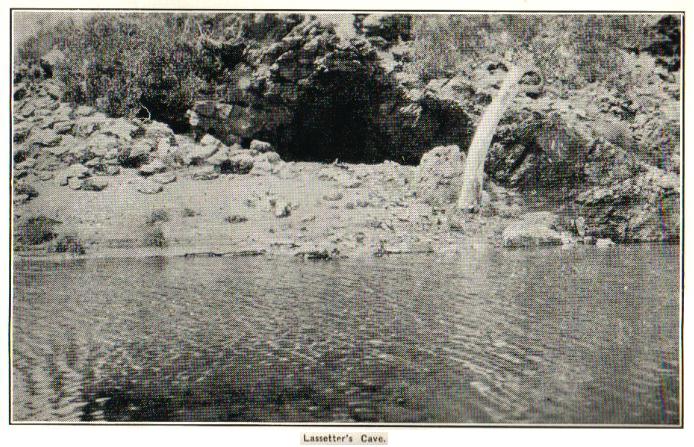152. LASSETER'S CAVE. |
|||
| "Here I am established with plenty of water but no food". | |||
| Idriess, Ion L. Lasseter's Last Ride. 240. From page 12 of Lasseter's Diary. | |||
|
Lasseter's cave is located on the banks of the Hull River where the usually dry watercourse passes north through the Mannanana Range. Contrary to the writings of Lasseter, Idriess and Coote and later recycled histories, the cave is not located at Winter's Glen, some twenty or more miles to the south east, where Lasseter perished in March 1931. Like the resurrection of Old Warts in later editions of Lasseter's Last Ride, Idriess blithely ignores the contradiction between the first three editions of his bestseller and subsequent editions regarding the location, indeed the existence, of the cave, and events that occurred there. In the original manuscript, Idriess based the story of Lasseter's misadventures on the letters found on his body and made no mention of the cave. Later editions of Lasseter's Last Ride include an additional 20 pages dealing with the second C.A.G.E. expedition, lead by Bob Buck, and excerpts from Lasseter's diary, found buried in the floor of the cave. The contradiction lay in Lasseter's last letters, especially the 78 day letter, based on these notes, which Idriess perused in John Bailey's office, and his fertile imagination, he has Lasseter travelling far and wide with an Aboriginal tribe. The diary has Lasseter holed up in his cave or the near vicinity for at least 60 days, from about the time the camels bolted on 27/12/30 to shortly before he made a belated attempt to walk to the Olgas or Ayers Rock. Kingsley Love, the very competent radio operator on Donald Mackay's 1933 expedition to central Australia, had the dubious pleasure of travelling with Bob Buck through the Petermann Ranges. On the way to the expeditions base camp at the Docker River, Love paid a visit to Lasseter's cave and noted, "Written on the rock inside are the words, '60 days without food - can't last much longer'. On a tree just outside are bullet holes, being shots fired by Lasseter either for practise or perhaps to impress the natives". assuming Lasseter's diary is a creditable document, then he can be placed at the cave a fortnight, three weeks and a month after the camels bolted, and Loves report places Lasseter at the cave in late February or early March 1931. In another of those remarkable coincidences that occur with disturbing frequency throughout the Lasseter saga, the cave is first mentioned some five years before Lasseter's arrival. In 1926 Donald Mackay and Herbert Basedow trekked through the Mannanana Range and in his report on the expedition Mackay wrote the following, "On 9th July we came to a break in the Mannanana Range, through this gorge comes the Hull River, Its dry sandy bed 80 yards wide; passing through this gorge we found another compound bounded on the South West by the Pottoyu Hills. Here, like the country we had passed over since leaving the Ruined Ramparts drought conditions prevailed. We saw many native tracks and a small cave in the southern side of the gorge showed signs of having been recently occupied. Camping near here, flies, which had not seen so bad since leaving Charlotte Waters, were in millions. The Spinifex being very dry and inflammable we frequently when travelling set it alight as a friendly sign to the natives". Herbert Basedow wrote the forward to Lasseter's Last Ride, could Idriess or Lasseter have had prior knowledge of the caves location through Mackay's report or word from Basedow, perhaps not Lasseter, rather than set fire to the Spinifex as a friendly sign to the Aboriginals, he fired cannon crackers.
This photograph of Lasseter's Cave appears opposite page 140 of Errol Coote's Hells Airport and the message on the tree, opposite page 178 of Lasseter's Last Ride. Note that Coote places the cave at Winter's Glen. The original photo is the frontispiece to Lasseter's Last Ride and was taken by E. Brandon-Cremer, the photographer on the second C.A.G.E. expedition, lead by Bob Buck. The message on the tree faces the cave, not obvious to anyone searching for Lasseter. © R.Ross. 1999-2006 |
|||
|
Baume, Eric. Tragedy Track. opp page 87. Coote, E. H. Hell's Airport, Plate XXVIII. Idriess, Ion. L. Lasseter's Last Ride. 10thEdition 229-246. Lasseter's Diary. 12, 17, 19, 27. National Archives Australia. Mackay Expedition, Aerial Survey of Central Australia. Series Number, A431. Control Symbol, 1947/1640. Barcode, 68609. |
|||
|
 This unusual photograph of Lasseter's Cave appears opposite page 87 of
Eric Baume's book, Tragedy Track, published in 1933. A rare occasion
when the Hull River is well watered. Baume attributes the photograph to,
'Associated Newspapers Ltd; Sydney & Melbourne Herald'.
This unusual photograph of Lasseter's Cave appears opposite page 87 of
Eric Baume's book, Tragedy Track, published in 1933. A rare occasion
when the Hull River is well watered. Baume attributes the photograph to,
'Associated Newspapers Ltd; Sydney & Melbourne Herald'.